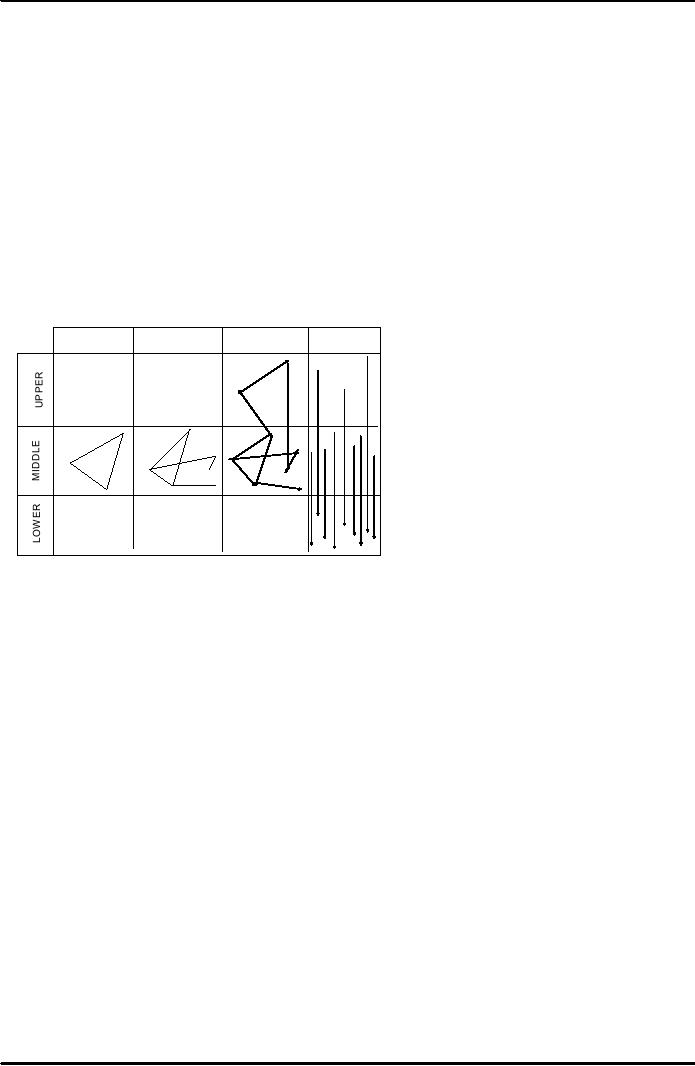 |
Management Styles and Roles |
| << STRATEGIC CHANGE |
| SYMBOLIC PROCESSES >> |

Change
Management MGMT625
VU
LESSON
# 27
Management
Styles and Roles
�
Education
and communication involve the
reasons for and means of strategic
change. Educating and
communicating
about strategic change might be
very time consuming activity, and
direction might not
be clear to
managers especially in large
organizations. Change may be
ineffective owing to
misinformation
and ineffective communication. For
strategic change to take place reliance
on top
down
communication processes may be
problematic.
�
Collaboration
or Participation in the change process is
the involvement of those who
will be affected
by strategic
change in the identification of strategic
issues, the strategic agenda, the strategic
decision
making
processes or the planning of strategic
change. This can help in
increasing ownership and
commitment
to change and change
process. It may entail the
setting up of project teams or
task forces.
Nonetheless,
this may prove to be more
time consuming process but
would lead to enhance the
quality
of decision.
Strategy workshops can be quite
useful for cross levels of
management to work on
particular
strategic problems, provide solution
within a larger strategic framework and
drive change
mechanisms
down to routine aspects of
organizational change
�
Intervention
is the coordination of and authority over
processes of change by a change agent
who
delegates
elements of the change process.
Change agent retains control though
interventions. For
example, at
particular stages of change
such as idea generation,
data collection, detailed
planning, the
development
of rationale for change and the
identification of critical success
factors are delegated to
project
teams. If such teams do not
take full responsibilities of the
change processes then
change
sponsors
tries to ensure the monitoring of
change progress.
�
Direction
involves the use of personal managerial
authority to establish a clear future strategy and
how
change
will occur. It is essentially top
down management of strategic change. It
may be associated
with clear
vision or strategic intent developed by
someone seen as leader in the
organization. There
are
different
styles of managing change. Two
broad categories are
directive and participative
styles.
Different
stages in the change process
may require different styles of
managing change. Directive
style
is speedy
and effective but runs the
risk of overall acceptance
while participation or intervention
may
be helpful
in gaining wider acceptance and
commitment across the
organization but at the same
time
tends to be
slower in its pace. If the
organization corresponds to the kind of
adhocracy, network or
learning
organization, it is likely to employ
collaboration or participation based
styles. In the most
extreme for
directive style becomes
coercive, engaged in the imposition of
change. This is a type
of
forced
learning entailing explicit
use of power but may be
necessary for the organization
facing crisis
or concerned
with large scale and rapid
organizational transformation. Such
type of transformation is
least
successful without crisis or creating
crisis.
�
Change
Agent Roles
Change agent
is an individual or group that affects
strategic change in organization. In
simple words
change agent
is the creator of change or strategy. These
may be senior executives or CEO, middle
level
managers,
and outsiders like consultants. Traditionally it is
the external consultants, especially in
the
Western
economies who are hired
for their specialized job and expertise
to come and visit organization
to
diagnose the
ailment and give prescription
for corrective measures in strategy or
structure. Another type
of change
agents are internal consultants or senior
executives, and can be identified as
strategic leaders
who
are well verse with
organization's problems and policies. The
approach of such in-house
strategic
leaders
could be legal, bureaucratic, transactional or
transformational. Nonetheless the common
prescription
is that strategic change could
take place meaningfully if the CEO or strategic leader
is
visionary.
Therefore we need a transformational or
visionary leadership in order to have strategic
change.
The
question of course now will
be what the attributes of such
type of leadership are. From
our own
cultural
perspective one such prescriptions is given by
our national poet as
66

Change
Management MGMT625
VU
The
attributes of a leader as someone who is
a visionary , true communicator a
communication which
touches
heart and full of empathy
and commitment who
stands committed and can have
feelings of
others
Another
perspective is MOUND model of change
management which emphasizes greater
role for the
middle
level manager as change agent.
Therefore, recall your
memories for Z theory of
management
which
says policy making,
implementation and organizational actions
will be most effective at
middle
levels of
management instead of top down (
theory X) or bottom up (theory
Y). This essentially is
known
as "ringsei"
in Japanese language which means
consensus oriented decision
making. The logic is that
is
the middle
level managers and their
network who have greater levels of
collegiality, communicability and
placed
strategically between senior executives and
lower level workers and supervisors to
bridge the gap
and hence
make organization effective in seeking
its goals and objectives
effectively. The
MOUND
model is
illustrated below:
T he Mound
Model for Change
MIDDLE
OUT
UP
DOWN
This
means ay idea or strategy which is
conceived by middle level of
any one function area or
department
quickly
moves out at the same
horizontal level to middle
level managers in other
function areas or
departments.
The idea or strategy soon
moves upward to senior executives and CEO, and
once they get
convinced by
newer suggestions make part of
organization wide policies. Hence the
new idea or strategy
then
quickly moves downward. The
MOUND model seems more
appropriate for managing
change in
large
organizations and bureaucracies where
distances between top level
managers and implementation
levels
are very high.
Recent
concept of change agent might
include lower level managers
and workers, especially
from
knowledge
worker and knowledge management
perspectives. The concept of
knowledge worker is that
all
members of
the organizations are considered
knowledge workers even those
who are the shop-floor
level,
have tacit
knowledge and know their job
best, and can contribute
effectively for organization
through a
conducive
learning environment.
3.
Levers for managing
strategic Change
The
followings are different levers
that can be employed to
manage strategic change:
�
Structure
and Control
Systems
Changing
aspects of structure and control of
organization are considered important
aspects of strategic
change.
But most of the time top
managers may change strategy
but behaviour and
assumptions remain
the same,
with the result that change
programme tends to be ineffective. What
is more important is that
whether the
proposed strategic change brings in
conformity of thinking values and system
or promotes
and incorporates
criticality? Generally when we
talk of system we mean to
stress uniformity,
conformity
67

Change
Management MGMT625
VU
and
stability but systemic
thinking also tend to
incorporate different views of
reality and critical
thinking.
Because system itself is
composed of various subsystems
having different demands
and
functions.
Therefore it is important for
change agents and change
leaders while designing structure
and
control
system that it should not
just be considered for manufacturing
consent instead should be
directed
to promote
knowledge and values appropriate for
strategic change.
�
Routines
Routines are
the organizationally "specific ways to do
things around here" which
tend to persist over
time and
guide people's behaviour. Routines
may also be considered as a double
edge sword in the
sense
that it may lead
organization to carry its operations in
distinct ways and achieve its
competitive
edge,
but also present a risk to
act to block change and
creativity, and may lead to strategic
drift.
Changes in
organizational routines can be a
powerful signal of and
stimulus for change because
change
in strategy
should correspond to change in
implementation or operations. But then
routines are closely
related
with the existing paradigm,
hence changing strategy means
changes in taken for
granted
assumptions
and taken for granted routines and ways
of doing things that are the
cultural elements.
Routines are
even considered more powerful than even
education and communication technique
of
changing
people. Thus changing routine is a
good technique to change
behaviour which may
help
people in
evaluating and changing their
beliefs and assumptions.
Therefore it is suggested for
managers
who
are trying to effect strategic
changes to take personal responsibility
not only for identifying
changes
in routines,
but also for monitoring
that they actually occur.
The changes may appear to be
mundane but
they
can have significant
impact.
68
Table of Contents:
- Introduction to Change Management
- BENEFITS AND SIGNIFICANCE OF CHANGE MANAGEMENT
- KURT LEWIN MODEL: ASSUMPTIONS AND IMPLICATIONS
- IMPLICATIONS OF KURT LEWIN MODEL
- SOME BASIC CONCEPTS AND DEFINITIONS
- TRANSACTIONAL VS. TRANSFORMATIONAL LEADERSHIP
- THEORIES OF CHANGE IN ORGANISATIONS
- Life cycle theory
- Teleological theories of Change
- Dialectical theories of change
- A DIALECTICAL APPROACH TO ORGANISATIONAL STRATEGY AND PLANNING
- LIMITATION OF DIALECTICS; DA AND DI
- THEORIES OF CHANGE IN ORGANISATIONS
- APPLICATION OF EVOLUTIONARY THEORY
- FURTHER APPLICATION OF EVOLUTIONARY T
- GREINER’S MODEL OF ORGANISATIONAL– EVOLUTION AND REVOLUTION
- GROWTH RATE OF THE INDUSTRY
- COORDINATION
- ORGANISATION ECOLOGY
- CLASSIFICATION OF ORGANIZATIONAL SPECIES
- FOOTNOTES TO ORGANISATIONAL CHANGE
- SOME COMPLEXITIES OF CHANGE
- ORGANIZATIONAL ADAPTATION
- PROSPECTORS
- SKELETAL MODEL OF ADAPTATIONq
- STRATEGIC CHANGE
- Management Styles and Roles
- SYMBOLIC PROCESSES
- COMMUNICATING CHANGE